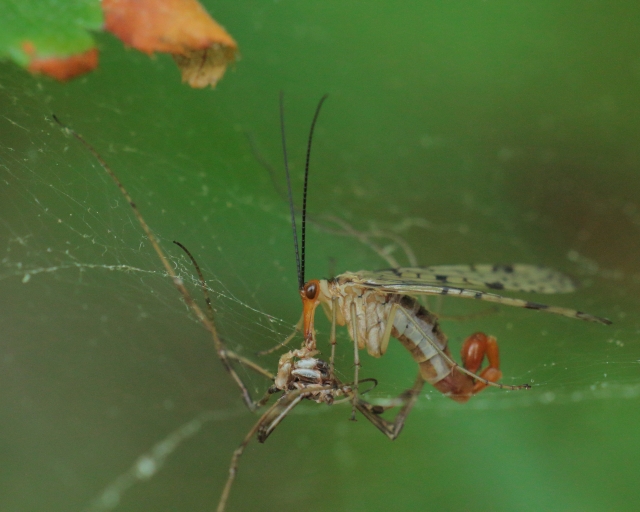By Kendrick Fowler
While seeking the subject for tomorrow’s post, I came across a scorpionfly scavenging the carcass of a daddy longlegs (aka harvestman) from a spider’s web. Scorpionflies are a small order of insects whose most common family, the Panorpidae, is comprised of species in which the males’ genitalia resemble the stinging tail of a scorpion (females’ abdomens are simply tapered). Most scorpionflies have elongate faces that bear more than a passing resemblance to a plague mask—an interesting coincidence since, as depicted here, most species habitually scavenge dead insects and arachnids.
I thought it was fascinating to witness the scorpionfly stealing a spider’s prey without becoming a meal itself: the spider, which was hiding under the leaf at the top left of the image, made no attempt (as far as I saw) to capture or chase off the scorpionfly, and the scorpionfly safely flew away when it finished its meal. When one organism consumes food that another organism captured or collected, that behavior is called kleptoparasitism. Given how comfortable the scorpionfly I found today seemed to be with spending time in the spider’s web, I have to imagine that the kleptoparasitic behavior I witnessed was not a unique event, and I wonder how common or important it might be in these insects’ ecology.
UPDATE 5 June 2020:
I did a little reading after this post went live last night, and it turns out that kleptoparasitism by scorpionflies on web-building spiders is a well-documented phenomenon and probably quite important in the ecology of some scorpionflies. Some scorpionfly species have been observed to acquire a large proportion (up to ~30%) of their diet from spiders’ webs, and to defend themselves aggressively when attacked by spiders. Scorpionfly populations sizes are apparently limited by food availability, and it has been speculated that their seemingly-risky kleptoparasitic behavior evolved due to the intense competition they experience in acquiring food. Fascinating!
If you wish to learn more, this paper (external link) might be a good place to start.


Pingback: Farmscape Wonder Wander: 7 August 2020 | Progress of the Seasons Journal
Pingback: Farmscape Wonder Wander: 2 June 2021 | Progress of the Seasons Journal